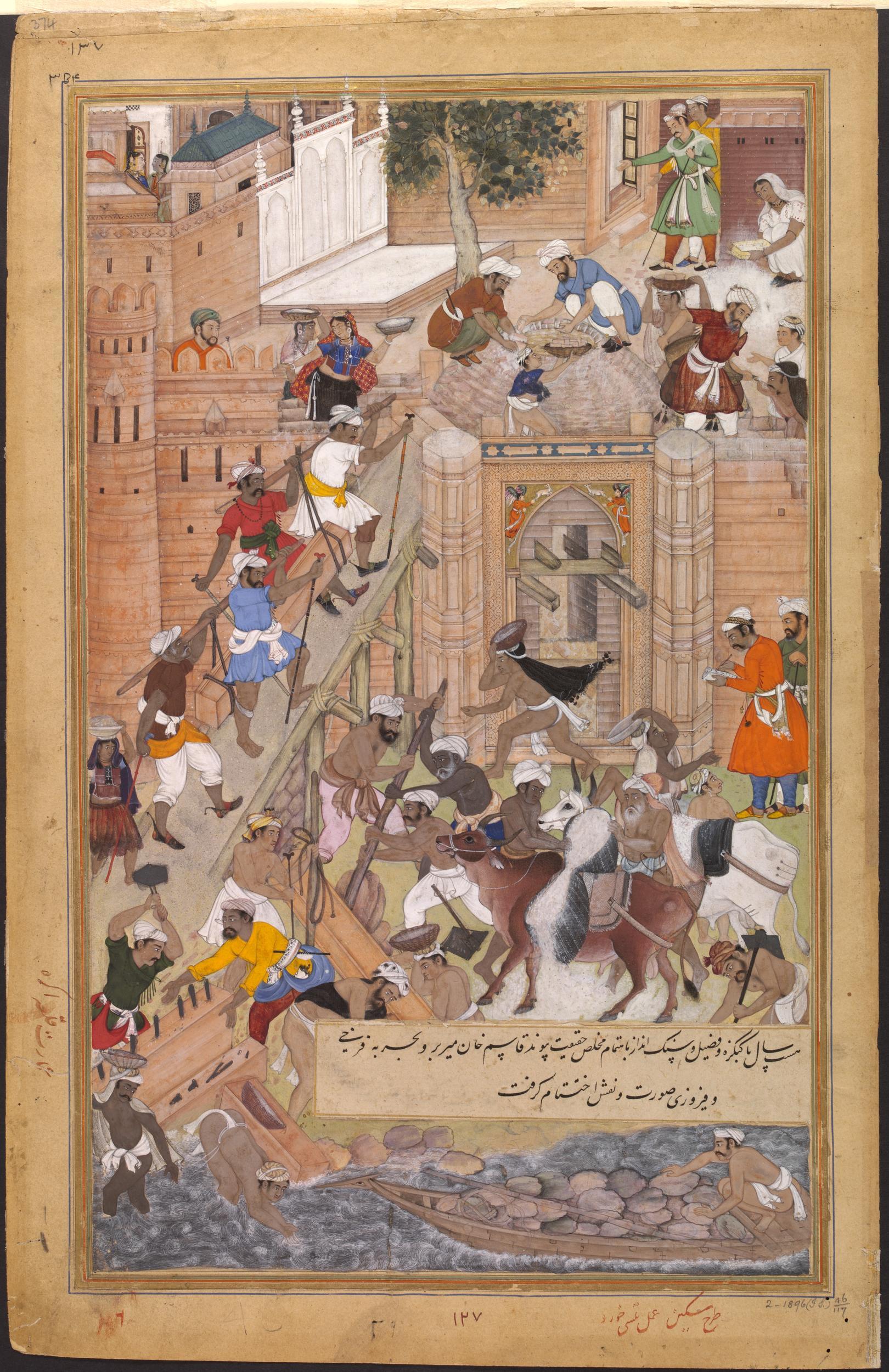

McEachern, Maxwell. “Essay: Construction of Agra Fort.” In The Akbarnama: A Digital Art History Student Project, April 4, 2018. .
Lucky enough to be involved some unprecedented research into the manuscripts of Akbar. The Akbarnama provides insight into his rule during the age of the Mughals in India. The manuscripts authored by Abu'l Fazl are inspired by works from the artists Miskina and Sarwan. This will be based on Pieces IS. 2:45 and IS. 2:46 which depict the construction of the Fort at Agra.
The fort that Akbar be demanded torn down and rebuilt, would be a major symbol for the importance of the architecture in the Mughal empire. It was said to be that four thousand men worked in the construction process. In the first image we can see close to thirty men just in this scene working away at the demolition and reconstruction process of the fort. The second image depicts the construction further along in the progress. The painting also gives clues as to which part of the fort that is being depicted. Research suggest that it is the Delhi gate at the Fort at Agra. Much like many painting from this period, it tends to depict many people in the scene and one that is not geographically accurate.
Akbar, as told from Volume two of the Akbarnama, said "with all its grandeur and glory, it became once more the abode of the caliphate, and the centre of the Sultanate." He wished, with the construction of this fort that Agra would become the new capital of the Mughal empire. As Akbar was seeing the Fort for the first time, his were a poetic verse as if to describe utopia. He likened the fertile soil to that of places like Iraq and climate so perfect that "fortune took up dwelling here". The river was a major source of inspiration as well for how his city was to be situated upon. Once Akbar made plans for the reconstruction of the city, he as a Mughal needed to draw upon his ancestors and construct architecture that would uphold the "dignity of his dominions". Akbar, with the help of four thousand workers, constructed a fort on the river which itself brought good fortune, and laid foundation using mathematicians and architects. It was important that Akbar follow his father and grandfather with grand structures that incorporate gardens.
Operating under the assumption that the paintings are depicting the Delhi Gate, research shows that the two pillars are octagonal towers that are built with white marble. The gate is also referred to as Hathi Pol, which means Elephant Gate. The reason for the name could be because the pillars look like elephant legs, large and demanding. However, the research suggests that there used to be massive red stone elephants that stood outside the gate. The idea was that the statues represented Akbar's capture of Chitor and how he vanquished the Rajputs.
The style of architecture that was used in the Mughal period varies throughout the existence. There does seem to be certain principles that were used for a majority of the buildings during this time. The key principles that were used at Agra were also applied to the Taj Mahal and spanned other architectural endeavours. The Mughals were known for their beautiful forts, tombs and mosques. Geometrical planning was the first major principle, the second is Billateral symmetry, this principle is not as prevalent on the Agra fort as it is on the Taj Mahal, but many parts of the fort follow a symmetrical principle. Hierarchy is of utmost importance, as it usually is able to portray a large, tall and overwhelming presence. Other principles include proportional formulas, uniformity, detail, naturalism as well as symbolism.
Empires have their own consistencies and legacies. The Mughals tend to be known for their beautiful gardens and architecture. Interestingly, Babur, the father of the Mughal period had a major hand in both of these themes. The Babur gardens are important because he had huge respect for them and created ingenious designs that blended with nature. His four-part gardens generally had water flowing through them which made access to water of great importance. This is why Akbar had his fort built next to the river Jamna, although there is no physical evidence that there are remnants of gardens, the fort does seem to be positioned and built for a garden as noticed by its paved surface of the grounds.
Mathematicians and Architects are shown in the painting. They laid the foundation for the fort and were brought in to do so. It is unsure if these intellects are Mughal or if they have been brought in from outside the empire. Akbar did have the capability to bring in the very best to build his fort. Looking at other aspects of the painting, the viewer can see men in clothing as well as shirtless men. Thought is that the shirtless men, were the heavy lifting labourers and the clothed men were the detail oriented that worked the stone, shined them like a "world revealing mirror" and placed them.